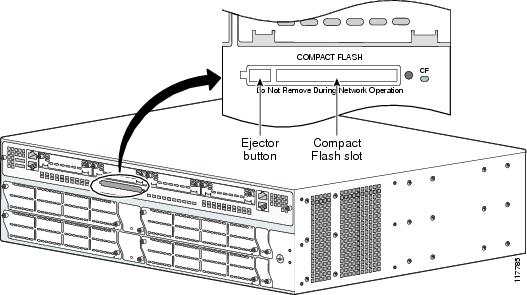

-
Cisco 3800 Series Hardware Installation
-
Cisco Access Router USB Flash Module and USB eToken Hardware Installation Guide
-
Introduction to Cisco 3800 Series Routers Hardware Documentation
-
Overview of Cisco 3800 Series Routers
-
Preinstallation Requirements and Planning for Cisco 3800 Series Routers
-
Installing Cisco 3800 Series Routers in an Equipment Rack
-
Connecting Cables to Cisco 3800 Series Routers
-
Powering Up Cisco 3800 Series Routers
-
Troubleshooting Cisco 3800 Series Routers
-
Installing Network Modules in Cisco 3800 Series Routers
-
Installing Interface Cards in Cisco 3800 Series Routers
-
Installing SFP Modules in Cisco 3800 Series Routers
-
Installing CompactFlash Memory Cards in Cisco 3800 Series Routers
-
Installing and Upgrading Internal Components in Cisco 3800 Series Routers
-
Table Of Contents
Installing CompactFlash Memory Cards in Cisco 3800 Series Routers
Preventing Electrostatic Discharge Damage
Removing CompactFlash Memory Cards
Installing CompactFlash Memory Cards
Installing CompactFlash Memory Cards in Cisco 3800 Series Routers
This document describes how to remove and install CompactFlash memory cards in Cisco 3800 series integrated services routers. It contains the following sections:
•
Preventing Electrostatic Discharge Damage
•
Removing CompactFlash Memory Cards
•
Installing CompactFlash Memory Cards
Preventing Electrostatic Discharge Damage
CompactFlash memory cards are sensitive to electrostatic discharge (ESD) damage. ESD damage, which can occur when electronic cards or components are handled improperly, results in complete or intermittent failures.
To prevent ESD damage, follow these guidelines:
•
Always use an ESD wrist or ankle strap and ensure that it makes good skin contact.
•
Connect the equipment end of the strap to an unfinished chassis surface.
•
Place a removed CompactFlash memory card on an antistatic surface or in a static shielding bag. If the card will be returned to the factory, immediately place it in a static shielding bag.
•
Avoid contact between the card and clothing. The wrist strap protects the card from ESD voltages on the body only; ESD voltages on clothing can still cause damage.
•
Do not remove the wrist strap until the installation is complete.
CautionFor safety, periodically check the resistance value of the antistatic strap. The measurement should be between 1 and 10 megohms (Mohm).
Removing CompactFlash Memory Cards
CautionDisconnect the router from the network before removing a CompactFlash memory card.
To remove a CompactFlash memory card from the router, follow these steps (see Figure 46 and Figure 47):
Step 1
Press the ejector button next to the CompactFlash card. The ejector button moves outward so that it projects from the panel.
Step 2
Press the ejector button again. This ejects the CompactFlash card partway out of its slot.
Step 3
Carefully pull the card out of the slot.
Step 4
Place the removed CompactFlash memory card on an antistatic surface or in a static shielding bag.
Step 5
Push the ejector button in until it clicks.
CautionTo prevent damage to the ejector mechanism, the ejector button must remain fully seated when not being used to eject a CompactFlash card.
Figure 46 CompactFlash Slot Location in Cisco 3825 and 3825-NOVPN Router
Figure 47 CompactFlash Slot Location in Cisco 3845 and 3845-NOVPN Router
Installing CompactFlash Memory Cards
To install a CompactFlash memory card, follow these steps (see Figure 46 and Figure 47):
Step 1
Make sure that the ejector button is fully seated so that it does not project from the panel.
Note
If the ejector button projects from the panel, push it in until it clicks.
Step 2
Insert the CompactFlash card into the slot until it is fully seated. The ejector button should remain flush with the panel.
Note
If the ejector button projects from the panel after you insert the CompactFlash card, remove the card, press the ejector button until it clicks, and reinsert the card.
CautionTo prevent damage to the ejector mechanism, the ejector bottom must remain fully seated when not being used to eject a CompactFlash card.
Using the Compact Flash Guard
The Compact Flash guard (CF-guard) provides protection for the compact flash memory slot.
Note
A small flat-head screwdriver is required to attach the CF-guard.
To install the CF-guard, follow these steps:
Step 1
Unpack the CF-guard.
Step 2
Slip the CF-guard flap into the notch in the CompactFlash memory slot.
Step 3
Screw the CF-guard into the screw hole.

 Feedback
Feedback



